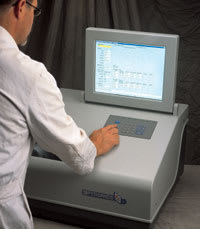ask the labs
Edging Poly: A Troubleshooting Guide
From the desk of Ask the
Labs, here are key polycarbonate lens processing challenges answered
By Karlen McLean, ABOC, NCLC
|
|
|
Prepare lenses before edging. Shown: ODI/Topcon system |
Perhaps more than any other lens material, eyecare practitioners seek advice on processing polycarbonate lenses with and without AR.
Concerned about breakage issues, ECPs need answers to help avoid costly and time-consuming product failure. Our advice from equipment experts helps provide up-to-the-minute information you need to get the finished poly results you want.
CHALLENGE A
When I use the poly setting on my edger, I still run into breakage when edging AR poly.
Solution 1: There can be several types of breakage associated with edging AR poly. One is breakage from twisting off axis. The key is to prepare lenses before edging.
Lens and AR manufacturers have technical documents that outline the proper way to prepare their lenses prior to edging. For example, special tapes must go on poly AR lenses prior to the leap pad and block.
Review technical documents for the products you carry and use the procedures they highlight. Simply following manufacturer's procedures may cure your problem.
Solution 2: If the diamond wheel is dull, you'll need to replace it. A dull diamond wheel can put too much torque on the lens. Another area to probe is the shaft rotation.
|
|

|

|

|
|
Crazing and cracking may appear immediately or days later. Look for equipment that cools the drill bit. Also, make sure there's not too much pressure on the lenses. Shown from top: Gerber Coburn Kappa CT; Briot USA Axcell, and DAC's Harmony, P4, and BluEdge |
If the machine is relatively old and hasn't been maintained or overhauled, this could lead to corrosion and failure of the bearings in the shafts. Be sure to service your machines as per manufacturer recommendation.
Solution 3: Try increasing chucking pressure, or run poly AR lenses through a slower, controlled cycle. Most new equipment features a delicate setting to cut special lenses slower.
Solution 4: If the AR coating is cracking, you may have too much chuck pressure on the lenses. Simply adjust for less pressure.
If the right side adapter that comes up against the back of the lens doesn't match the same geometry on the block on the front of the lens, it can create stress points that can cause cracking.
If reducing head pressure or running a slower cycle doesn't alleviate AR cracking, check with the manufacturer on AR product durability.
— Matt Vulich, vice president marketing, AIT Industries
CHALLENGE B
When I drill polycarbonate lenses—especially AR poly—sometimes the lenses crack or craze.
Solution 1: Poly cracking and crazing is often caused by high drill speed. The heat from the drill can compromise polycarbonate, which is a heat-sensitive lens material.
Cracking/crazing may exhibit right away, but can also show up days later. Slow down the rate of the drill. From full RPM, go to half-speed.
Solution 2: Look into equipment that cools the drill bit, for example, that offers water processing during milling. Cooling the drill can eliminate cracking/crazing in poly and other lens materials.
Solution 3: Check the condition of your drill bit often, and replace it regularly. Drill bit dulling can cause fractures/chips on poly lenses, especially AR poly.
Use an eye-loop or other magnifier to check drill holes; a close inspection can detect if your blade is getting dull. Carefully use the de-burring tool, and replace it regularly as well.
Solution 4: High pressure stresses poly. Apply lighter pressure during processing, lens mounting, and frame adjustments. Don't stress the drilling hole, especially when working with compression-mounts.
Bending rimless mounts by hand can cause lens cracking/crazing. Instead, use tools that are designed for rimless mounts, including a nylon-jawed plier to help support the frame while bending.
— Abel T. Brown, West Coast sales manager, Briot USA
|
|

|

|
|
Follow equipment manufacturers' instructions for proper use and maintenance of edging equipment. Shown from top: National Optronics' 7E system; Santinelli International's edging equipment |
CHALLENGE C
Occasionally, when I groove poly rimless lenses or bevel poly lenses for metal frames, the lenses chip or flake.
Solution 1: If a semiautomatic groover is being used, make sure the grooving wheel is clean.
Polycarbonate has a tendency to build up in the spaces between the diamond grains. Use a small wire metal brush to remove this material accumulation.
Solution 2: The same applies to the beveling wheel if a dry/wet automatic edger is being used to bevel poly lenses. Be sure to keep the wheel clean.
If a dry-cut edger is being used, make sure the cutting/grooving tool is very sharp to help avoid stress against the lens. Follow equipment manufacturer instructions for proper use and maintenance of diamond wheels and cutters.
— Bill Galindo, vice president sales and marketing, ODI/Topcon
CHALLENGE D
When I edge poly lenses and insert them in metal frames, the lenses sometimes crack.
Solution 1: To help eliminate lens cracking or chipping in metal frames, try polishing the edge of the lenses.
Solution 2:
Do not use acetone on the lenses or use mark-off to take the markings off lenses,
since cracking or chipping can show up immediately or even some
time later.
Solution 3: Do not over-tighten the screws in metal frames, since this is often the cause of chips and cracks.
� David Steinbach, sales manager, Lab-Tech, Inc.
polycarbonate q & a
|
|
|
An inside look at Lab-Tech's edging unit |
These core polycarbonate lens processing questions and answers are geared to make your core poly problems disappear.
q: Wrap It Up
How can I best work with high-wrap polycarbonate lenses?
answer: It's best to match your lens' base curve to the frame curve as closely as possible.
There can be cases that you will not want to fill certain prescriptions
in certain frames. For instance, you may not want to put a -5D power in an eight
base frame.
Some manufacturers make recommendations that an Rx not be placed in specific frames. There are good reasons why they make various recommendations—from simple cosmetic [appearance] reasons to different functional reasons, such as the lens popping out of the frame.
Many aspheric lens designs minimize [visual] distortions that patients may experience and should be utilized whenever possible.
In regard to equipment, it's best to match the bevel profile as closely as possible to achieve the best fit in the groove of the frame. There are edgers on the market today that have a variety of bevel profile blades that accomplish this easily.
— Russell A. Gagain, LO, ABOC, NCLC, testing and finishing manager, Gerber Coburn
q: Ready for Poly
What type of consumables should I have on-hand for poly processing, especially AR poly?
answer: Processing AR poly can be challenging. A system of pads that work together is the best solution.
Consider one-step fining pads specifically designed for poly lenses. These specialized pads provide quick and consistent stock removal while preventing swarf loading, swirls, and other heat-related fining problems.
Complement the fine process with a superior polish on the surface of the lens where it's the most effective. Polish pads with high absorption capabilities enhance stock removal, especially on cut-to-polish or poly one-step applications.
A quality-edging pad should withstand axis failure while offering a solid bond between the block and lens.
— David Meisenheimer, executive vice president – sales and marketing, DAC Vision
q: Shining Through
How do I achieve different types of polished edges on poly: Lightly polished, medium polished, and highly polished?
answer: In addition to normal factory settings for individual lens material, we have the capacity within our latest systems to define the polish preferences by material within a setup screen on the edger.
There are several parameters, such as the number of revolutions a lens will spend on the polishing hub and the amount of takeoff desired, for example, that can be customized to achieve various polish levels
The customization is named and will display on the edger job screen as an option.
— Susan Polson, director of external operations, National Optronics





